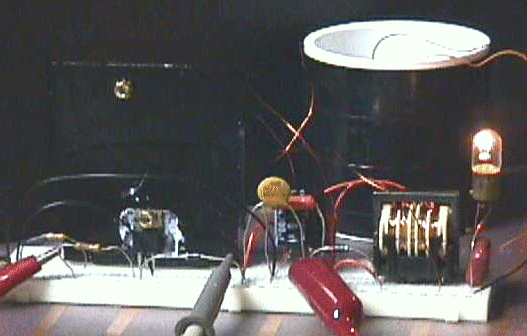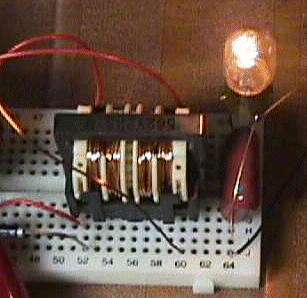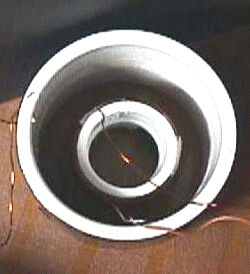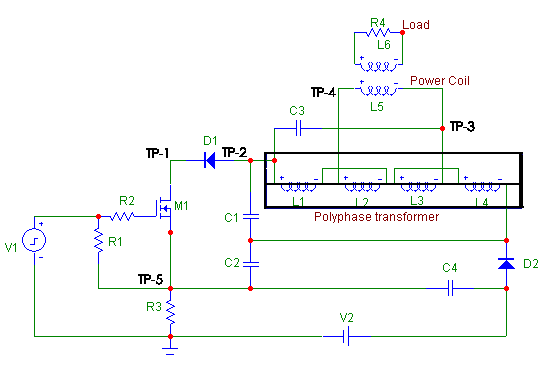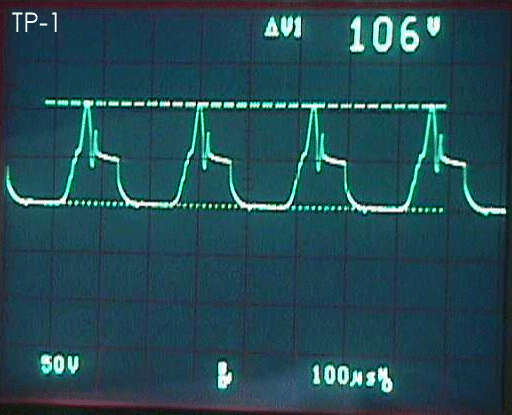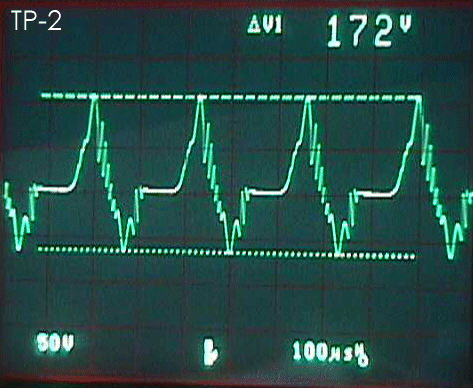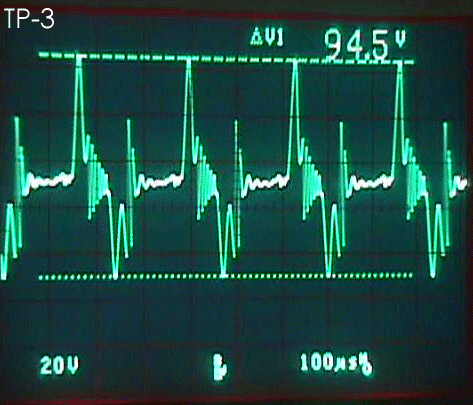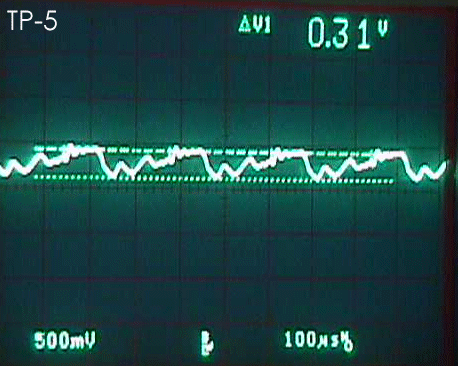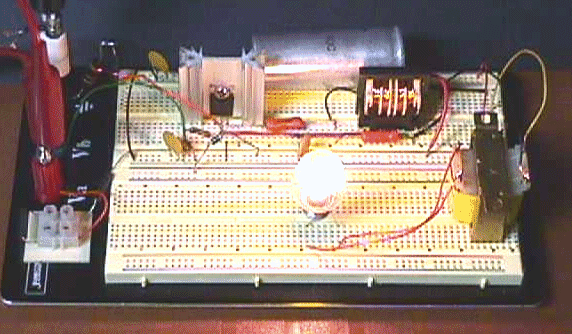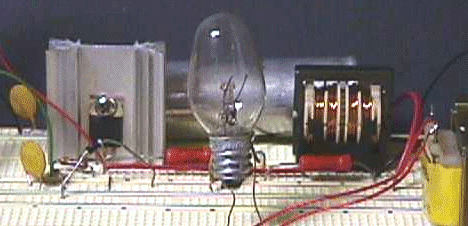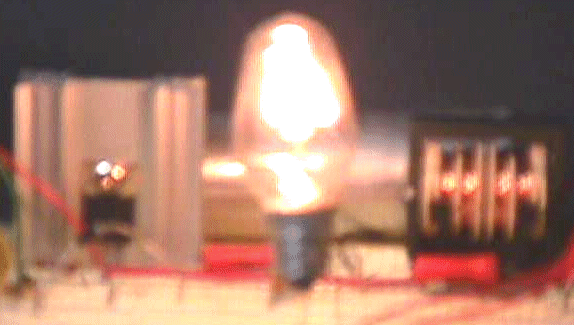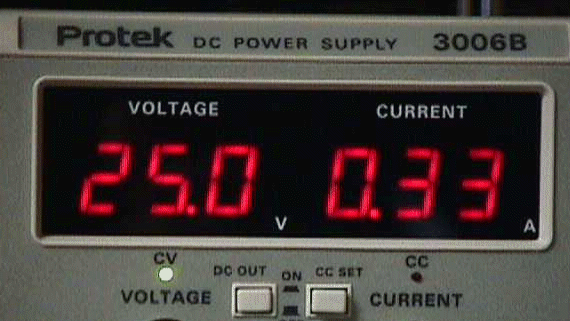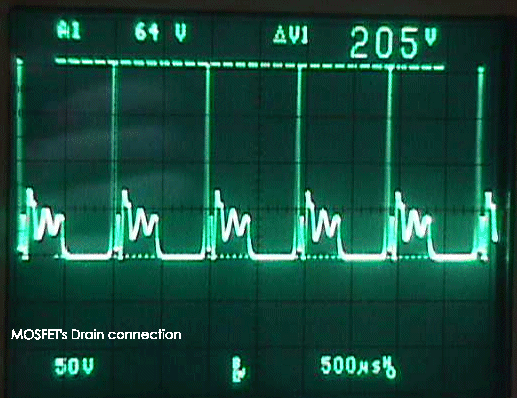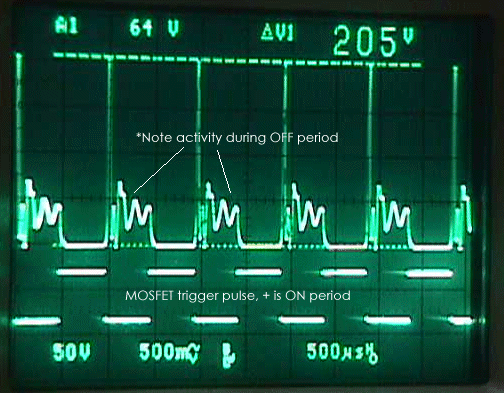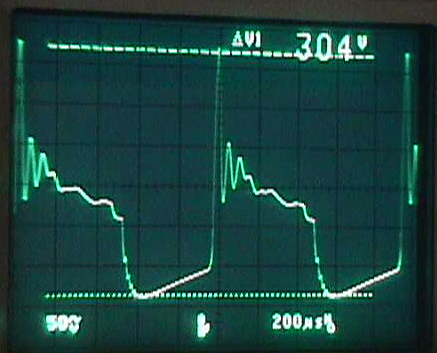|
Spatial Energy Coherence ECAT
An ECAT circuit variation with a large air core coil in the background
Shown on this page are some of the first ECAT
circuits I built in 1993-1994 while on the team of the Advanced
Technology Group. The circuits consisted of air core coils
varying in size and winding configuration. The underlying ECAT theory
was to use cross phasing of various frequencies in such a way as
to produce a virtual energy pump thereby providing an
anomalous power gain within the circuit.
Various researchers in
the so-called Free Energy1 area have focused on various
configurations of pulse capture circuits where the back EMF of an
inductor was thought in some way
to capture energy from the ether and add it back
into the circuit, thereby presenting gain. As with any free-minded group the
Fee Energy folks seemed totally against ever duplicating in detail a particular circuit offering
by me, and for whatever reason used modified designs or components hoping
there magic was just as powerful as the original experimenter. This
resulted in many Internet published attempts at duplicating one or
more of the ECAT circuits and of course leading to
total failure by those trying. There is one so-called acid test proposed by those wishing to suppress certain research, using applied terms such as 'Over Unity', a condition where (Output/Input or (COP4) > 1). This proclaimed test states that such a device must self-run, producing an unlimited source of power without any external input energy. This proposed test is totally a diversion from the truth and is proposed as a way for energy utilities, suppliers and regulators to hide or otherwise discredit valid research in this area. Let me try to explain in somewhat simple terms what the last paragraph is really about and why I can show that the so-called acid test is invalid. You need to form a mental picture of two areas separated by an infinite wall and a large door between the two areas. On the other side of the door is endless potential energy in the form of a high-speed wind. On your side you have a wind generator just waiting for a wind to begin providing you with electricity. All that is needed is to open the door and allow the wind to drive your wind generator and you have an endless supply of electricity. So far it seems simple enough, just push the door open, get the generator working and use some of the produced electricity in a device to keep the door open. It won't work this way and I hope I can present a clear picture of just why it will not.
So what is Polyphasing? Another example is in order, assume you are standing on a crowed street corner in New York City, where the ambient noise would be defining, yet you would be able to hear and identify individual sounds at different sound levels (pressures) and frequencies. The sound you hear is a mix of all audible sounds around you, some weak, some normal and some extreme in loudness. If you could in some way selectively pick certain sounds and properly phase them, you could arrive at a sound pressure greater than any one of the individual sounds. This is ECAT, it coheres the energy around it in such a way that it can be absorbed by its air core coil, resulting in an overall increase in kinetic energy. The basic ECAT circuit with the polyphasing transformer which is the center point this ECAT design
This ECAT
design is operated at a respectable frequency of 4.3Khz, the trigger
frequency and resulting sub frequency on which the power harmonics
are developed. The polyphasing transformer is of a Theta core design
and is made from a material that saturates at a desired saturation
point. The space between the power coil and the load coil is the area
from which the additional energy is absorbed. This ECAT circuit is initialized with a 12V DC supply, either battery or some form of converter. The driver pulse 50% duty cycle supplied from a conventional generator or solid state multi-vibrator and drives a single MOSFET transistor. The test points are indicated in the upper left corner of each image
Conventional
electronic engineering considers spurious phenomenon an unwanted
artifact and uses various methods of filtration and feedback to
cancel and remove such phenomenon. By today's standards this ECAT
circuit is considered to be a very poorly designed switching
circuit.
The next photo shows ECAT and its 12 watt ligh bulb before power is applied.
The next photo is another closeup of ECAT driving the 12 watt lamp.
In the preceding photo, notice the strange light at the bottom of the bulbs filament. This light is from high voltage arcing at the base of the bulb. The input power rails are stabilized with both 0.01uf ceramic capacitors along the rails and one very large 2kuf capacitor to insure the voltage does not contain low ripple or high frequency components.
Considerable design information was obtained during tests arriving at this point in ECAT history. The following scope photos show what is seen at the switching MOSFET drain during the OFF cycle of the pulsed operation. As can be seen, the excess energy capture occurs during the OFF period of the MOSFET.
In earlier ECAT designs (top of page) one can see that a large heat sink was used on the MOSFET driver, while in this design one can see that the heat sink has been drastically reduced in size and is only required should the load be disconnected from the circuit. During a load condition the quiescent current is only 90ma, yet if the load is mismatched, the current can go well over 1amp and the MOSFET begins to heat. Under normal operation the MOSFET and its heat sink is cool (not cold like the transformer) but cool. With addition of an HF matching transformer the following scope photo is what is seen on the secondary of this matching transformer. As can be seen the secondary voltage is quite high and the pulse shape is more uniform than with the older 60Hz transformer.
REFERENCES (3) CTG Labs3 TEP research can be found at http://www.ctglabs.com/time_energy_pump_project.htm (4) COP stands for Coefficient of Performance. Copyright 1993-2007 Stiffler Scientific. All rights
reserved. |

